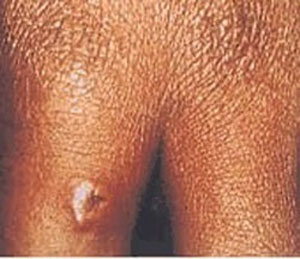History and exam
Key diagnostic factors
common
history of exposure
Environmental exposure is the strongest risk factor. Cutaneous anthrax can be acquired from contact with infected animals or contaminated animal products, such as hides, wool, hair, and ivory tusks. Other risk factors include occupational exposure to animal hides and wool (inhalation anthrax), bioterrorism, ingestion of undercooked meat (ingestion anthrax), or heroin use (injection anthrax).
necrotic skin lesions (cutaneous)
Characteristic skin lesions of cutaneous anthrax begin as a pruritic, painless papule 2-5 days after exposure. The lesion becomes vesicular, evolving into a necrotic black eschar with massive surrounding edema 24-36 hours later.[59][Figure caption and citation for the preceding image starts]: Mild cutaneous anthraxwww.cdc.gov [Citation ends].
painless lesions (cutaneous)
Despite the massive edema associated with cutaneous anthrax lesions, the wound is characteristically painless.
edema (cutaneous)
influenza-like illness (inhalation)
Patients with inhalation anthrax typically describe an influenza-like illness, including fevers, myalgias, and malaise.[37]
Symptoms of congestion and coryza are notably absent.
respiratory symptoms (inhalation)
Nonproductive cough and chest discomfort may be seen in inhalation anthrax.
Decreased breath sounds may suggest characteristic pleural effusions, but clinical signs of pneumonia are variable or may be lacking.
uncommon
oropharyngeal ulceration (ingestion)
A rare complication of spore ingestion.
Local edema and sore throat are accompanied by pseudomembranous ulcers of the posterior oropharynx, involving the tonsils in 72% of oropharyngeal cases.[60]
Other diagnostic factors
common
lymphadenopathy
signs of meningitis
Approximately 14% to 37% of patients develop meningitis, depending on the route of transmission. All patients with signs and symptoms of systemic anthrax should be evaluated for meningitis. Meningitis may complicate any form of anthrax and may also be a primary manifestation.[1]
Primary symptoms of meningitis include fever, headache (which is often described as severe), nausea, vomiting, and fatigue. Meningeal signs (e.g., meningismus), altered mental status, and other neurologic signs such as seizures or focal signs are usually present.[2]
Patients are likely to have anthrax meningitis if they meet either of the following criteria: ≥2 of the following signs or symptoms - severe headache, altered mental status, meningeal signs, or other neurologic deficits; OR ≥1 of the following signs or symptoms - severe headache, altered mental status, meningeal signs, or other neurologic deficits AND ≥1 of the following signs or symptoms - nausea/vomiting, abdominal pain, or fever (either subjective or measured) or chills.[1]
uncommon
hypotension
May occur in severe systemic, inhalation, or ingestion anthrax.
If left untreated, systemic infection may lead to pulmonary and cardiovascular collapse within 1-3 days.[7]
gastrointestinal symptoms (ingestion)
Symptoms of gastrointestinal anthrax include nausea, vomiting, and diarrhea (bloody or nonbloody). Severe abdominal pain and rebound tenderness are suggestive of an acute abdomen.
Risk factors
strong
environmental exposure
Cutaneous anthrax can be acquired from contact with infected animals (e.g., sheep, cattle, goats, other herbivores) or contaminated animal products, such as hides, wool, hair, and ivory tusks.
occupational exposure
Cutaneous anthrax can be acquired from contact with infected animals (e.g., sheep, cattle, goats, other herbivores) or contaminated animal products, such as hides, wool, hair, and ivory tusks. Inhalation anthrax has been linked to the large-scale preparation of animal hides and wool (woolsorters' disease), as spores are aerosolized and subsequently inhaled during the process.[34][35][36]
biologic terrorism
A wide-area aerosol release of Bacillus anthracis spores would likely result in a mass-casualty incident, potentially complicated by the use of genetically engineered strains that are resistant to first-line antimicrobial drugs.[1] Clustered cases of anthrax suggest a common, potentially intentional exposure.
In 2001, 22 US postal workers developed anthrax (11 inhalation, 11 cutaneous) via intentional contamination of the mail.[16][17]
Anthrax is considered a biologic weapon; any febrile illness followed by rapid deterioration in an otherwise healthy patient should raise clinical suspicion.[37]
undercooked meat ingestion
Use of this content is subject to our disclaimer